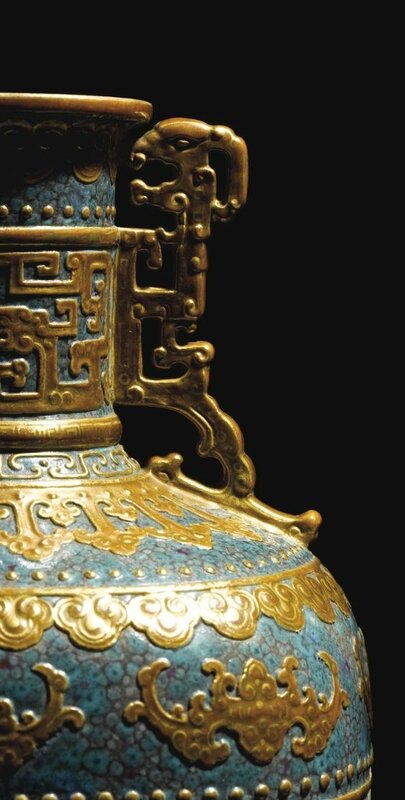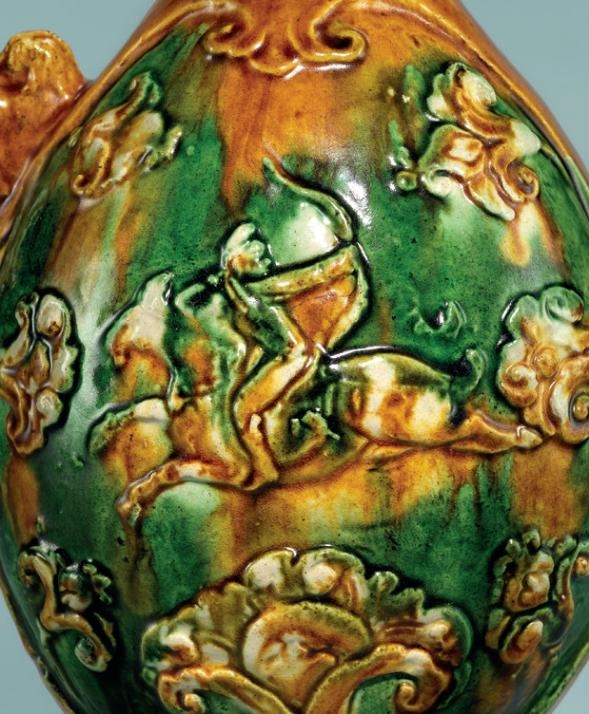![Lot 508]()
![1]()
![2]()
Lot 508. An important documentary blue and white altar vase, Qing dynasty, Qianlong period, dedicatory inscription of Tang Ying, dated to 1741, 64.1 cm., 25 1/4 in. Estimate Upon Request. Sold 11,520,000 HKD. Photo Sotheby's.
finely painted overall in vivid tones of underglaze-blue enhanced by simulated 'heaping and piling', the broad shouldered body with a reserved panel to one side enclosing a seven-line inscription, surrounded by lotus blooms borne on dense scrolling leafy stems, of which the larger blooms enclose a central shou character roundel, between two bands of ruyi heads, with bands of fan motifs and lappets around the collar into which the separately potted neck is inserted, the trumpet neck decorated with a composite floral scroll meander, between a classic scroll at the mouthrim and a band of stylised plantain leaves rising from the collar, all supported on a layered base decorated with a classic scroll and keyfret above lotus motifs and lingzhi scrolls, with pendant leaves and keyfret encircling the footrim. Quantity: 2
Provenance: Passed down in the family of a French surgeon since the 19th Century.
Acquired in France in 1984.
Note: The inscription can be translated
'Made under the general supervision of the Yangxindian. Representing the ruler, the Commissioner of the three Customs Stations of Huai[an], Su[qian] and Hai[an] in Jiangnan and at the same time Superintendent of Ceramics at Jiangxi and Supervisor of Taxes at the Jiujiang Customs Office, Vice Director of the Imperial Household Department and Assistant Chief Clerk promoted by five ranks, Tang Ying of Shenyang, has respectfully made and offered this in perpetuity before the altar of the Saintly Mother Heavenly Immortal of the Eastern Embankment, on a lucky day in the spring of the sixth year of Qianlong.'
According to this inscription, vase was made for a Daoist temple. Stephen Little (Taoism and the Arts of China, The Art Institute of Chicago, 2000, pp.278f.) states that the term 'Saintly Mother Heavenly Immortal of the Eastern Peak' (Dongyue Tianxian Shengmu) refers to Bixia Yuanjun, the 'Sovereign of the Clouds of Dawn', 'the most popular female Taoist deity in China during the Ming and Qing dynasties'. In Tang Ying’s inscription Dongyue ('Eastern Peak') is replaced by Dongba('Eastern Embankment'), which may be a misspelling, but has also been interpreted as referring to an area in Beijing.
Undoubtedly the most innovative and talented spirit of Qing China’s porcelain industry was Tang Ying (1682 - 1756), a bondservant of the Plain White Banner at the Imperial Household Department, who had served at the court in Beijing from the age of 16. Before he became a master potter, he had already been well versed in painting and calligraphy – accomplishments that helped him later in his career to boost the quality of porcelain decoration at the Imperial kilns. While still serving the court in Beijing, the Yongzheng Emperor already had him create designs for porcelains produced at Jingdezhen. In 1726 he was sent to supervise the Jingdezhen factories himself, and continued his services during the Qianlong Emperor’s reign.
In the fifth and sixth year of the Qianlong reign (AD 1740 and 1741), Tang Ying commissioned a number blue-and-white altar garnitures for temples in the vicinity of Beijing. These garnitures would have consisted of five pieces, an incense burner, two candlesticks and two vases, but no such Tang Ying altar set appears to have survived.
The present vase and its pair from the collection of T.T. Tsui, both reputedly still together in the late 19th century, were made in the same year for the same temple as a pair of candlesticks in the Victoria and Albert Museum, London, all being identically inscribed. It is most interesting, however, that at the same occasion, Tang Ying appears to have made not only one but two such garnitures for the same temple, since the National Museum of China, Beijing (formerly the Museum of Chinese History) owns another vase with this inscription, which shows slight variations in the decoration. For the T.T. Tsui piece see The Tsui Museum of Art. Chinese Ceramics IV. Qing Dynasty, Hong Kong, 1995, pl.73; for the candlesticks, Rose Kerr, Chinese Ceramics. Porcelain of the Qing Dynasty 1644 – 1911, London, 1986, p.69, pl.45; and for the vase in Beijing, Zhongguo wenwu jinghua daquan. Taoci juan, Hong Kong, 1993, no.913.
![Pair of candlesticks with a inscription within a cartouche on the foot, China (Jingdezhen), Qing dynasty, Qianlong period, dated 1741]()
![3]()
Pair of candlesticks with a inscription within a cartouche on the foot, China (Jingdezhen), Qing dynasty, Qianlong period, dated 1741. Porcelain painted in underglaze cobalt blue. Height: 67 cm, Diameter: 23 cm. Dorothy Bushell Gift, FE.129-1975 © Victoria and Albert Museum, London 2017
Long inscription on body : 'Made by the Chief Superintendent of Works in the Yang Xin Dian. Respectfully made by Tang Ying of Shenyang, imperially appointed Superintendent of the three Customs Barriers at Huaian, Suquan and Hai'an in Jiangnan, and also Controller of Pottery in Jiangxi and of custom affairs at the customs house in Jiujian, Junior Secretary of the Imperial Household and Captain of the Banner promoted five honourary ranks, and given as an offering in perpetuity (to stand) before the Holy Mother of God of Heaven at Dongba. An auspicious day in the spring of the sixth year of Qianlong.'
In the previous year, 1740, Tang Ying had already commissioned at least three similar altar garnitures for different temples at Dongzhimenwai just outside Beijing. Of one such set, made for the Holy Mother of the Immortals, a pair of vases is extant, preserved in the Shanghai Museum and published in Wang Qing-zheng, Underglaze Blue & Red, Hong Kong, 1987, pl.124; of another, made for the Bodhisattva Ksitigarbha, a single vase is preserved, formerly in the collection of the British Rail Pension Fund, sold in these rooms, 16 May 1989, lot 39; and of a set made for Guanyin, a pair of candlesticks has survived and is now in the Roemer-Museum, Hildesheim, Germany, illustrated in Ulrich Wiesner, Chinesisches Porzellan. Die Ohlmer’sche Sammlung im Roemer-Museum, Hildesheim, Mainz, 1981, pp.44 and 108.
The inscription on the present vase and its companion pieces made in the same year varies slightly from the inscriptions of the previous year, particularly in listing Tang Ying's titles somewhat differently. Also, the present inscription does not specify how many pieces Tang Ying donated on this occasion.
Peter Lam ('Tang Ying [1682 - 1756]. The Imperial Factory Superindendent at Jingdezhen', Transactions of the Oriental Ceramic Society, vol.63, 1998-9, pp.65-82), mentions (p.76) that 1740 and 1741 were eventful years for Tang Ying. In 1740, he celebrated several important events, the compilation of a volume of poems, the commission to write a preface to the local gazetteer, and the birth of his third son, while in 1741 his fortunes seemed less positive, with the Emperor complaining about low quality production and asking for a full financial report of Jingdezhen’s activities.
Although no matching inscribed incense burner appears to have survived, the lost censers might have been similar in style to some uninscribed Qianlong tripods decorated with lotus scrolls and formal borders, such as the censer sold in our London rooms, 13 December 1988, lot 248.
Sotheby's. Important Chinese Art: The Collection of a Parisian Connoisseur, Hong Kong, 08 Apr 2007




















































